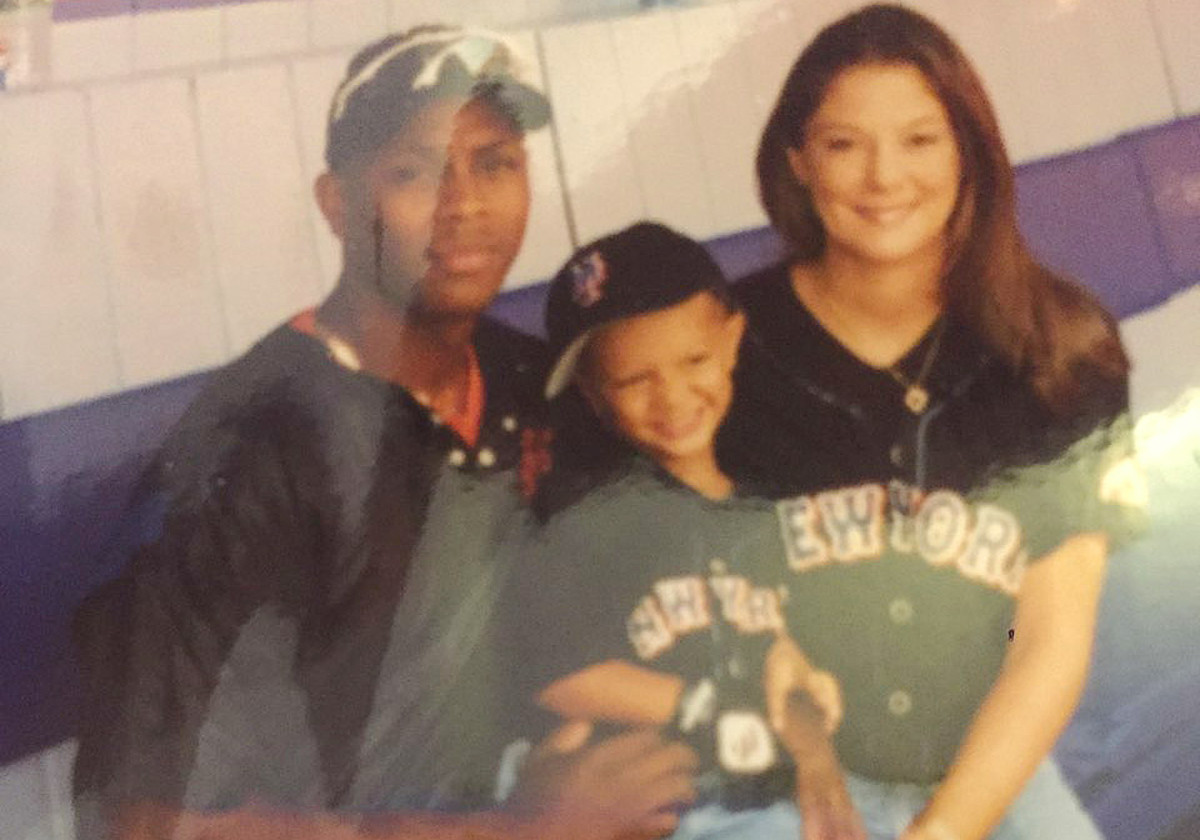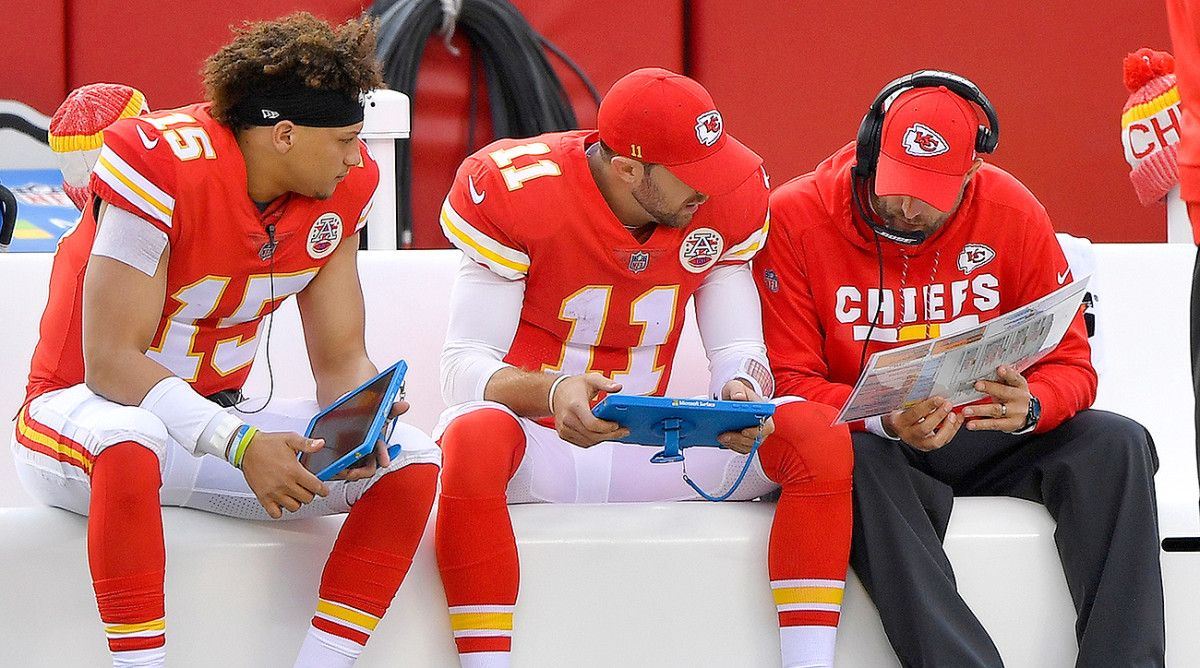Patrick Mahomes Is Ready to Show Off His Fastball

A version of this story appears in the April 23–30, 2017, issue of SPORTS ILLUSTRATED. To subscribe, click here.
Last April, when the Chiefs traded up to draft Patrick Mahomes No. 10 out of Texas Tech, he became their quarterback-in-waiting. After Kansas City agreed to trade three-time Pro Bowl QB Alex Smith to Washington in January, the wait was over. Mahomes learned what it takes to be a pro from an early age, when he was toted to ballparks by his dad, Pat, who pitched in the majors for 11 seasons. The younger Mahomes was also a right-handed pitcher—and an MLB draft pick by the Tigers—but he will use his powerful arm to get touchdowns instead of strikeouts. The MMQB asked the 22-year-old Mahomes the lessons he’s learned to prepare him to be the face of a franchise—from growing up around pro sports, from having Smith as a mentor and from that tantalizing sneak peek he gave us as a rookie.
Playing the scout-team quarterback in practice really helped develop my game. When we were playing the Jets, with Josh McCown, I'd have to throw a lot of deep balls. Tyrod Taylor with the Bills, you'd have to scramble around a lot. With Tom Brady, it was about dissecting the defense. You go through other offenses, and you make them into your own, and try to make it relate to your offense. I had to do stuff I wasn’t comfortable with, and see what I liked and what I didn’t like.
You dream of your first NFL start when you're a little kid, playing football in the backyard, but until you get there, you never know what to expect. The Week 17 game against the Broncos [in which Mahomes completed 22 of 35 passes for 284 yards] is something that will help me moving forward—to have gotten a full start in, to really go deep into the game plan with Coach [Andy] Reid and assistant [Mike] Kafka. There are things that, being a backup, you try to do, but you can’t get the full comprehension of what it takes. It helped me get perspective of what it takes to win football games in the NFL.
Coach Reid is a great teacher. He understands how people learn, understands how to get people to get the concept of what the play is and why we're running it. It helped me a ton being able to know exactly what I need to do and what I need to look for on every play.
I remember my first NFL interception vividly. On the second drive of the game, receiver De’Anthony Thomas was open and I overthrew him. I remember going to the bench and just sitting there and thinking, Well, you got that out of the way. I had been feeling jumpy and jittery and really excited when the game started, and after that interception, it’s almost like it settled me down and helped me get back into the mind-set of not trying to do too much. Those things happen in the NFL, but as a quarterback you have to minimize those. You have to have a short memory and go back out there and act like nothing happened.
I learned a lot from running a two-minute drive in the 27–24 win at Denver. I almost threw an interception; it’s about just knowing when to take chances. You’re going to make mistakes, but at the same time, having those successful finishes and those wins makes it so much sweeter.
I was in major league clubhouses for pretty much my whole childhood. You saw All-Stars working just as hard as guys who just got there. I remember Alex Rodriguez being at the stadium three or four hours before practice started, just hitting off a tee. Then you see Derek Jeter taking ground balls all day, and you’re like, these guys, they don’t have to be doing this. They’re the best at their profession, but at the same time, they want to be better. You understand that you have to work that hard, no matter what level you are.

LaTroy Hawkins—my dad’s former teammate and my godfather—is a great role model. He’s a professional in every aspect. He was always trying to do whatever he could to make the team better, to get his body in the best shape, so that whenever he got his opportunities, he took full advantage of them. That’s why he ended up having a 21-year career as a pitcher. This being my first professional offseason, I have spent time with my family, enjoyed life, but at the same time I’m working every day to make sure I’m ready for when OTAs, mini-camp, training camp and the season comes.
I threw with pretty much everyone on our team at least once this offseason. Whenever anyone was back in Kansas City, we would try to get out and get some work in. We had a group text going; I’d just text the guys, and whoever was in town, they’d say, Alright, I’ll be out there whenever you want to go. We weren’t allowed to throw at the facility in the offseason, so we went to some high schools around town—Shawnee Mission out in Overland Park, Kan., and Bishop Miege, a private school near Country Club Plaza. With the group of guys that we have here, they want to work, they want to get better. So for me, it’s easy.
Entering an NFL locker room at 21 years old, my mindset was pretty much just to go out there and work hard. People respect you if you work hard. And if they think you can win, they’ll like you.
I didn’t start playing football a lot until I was in high school. I played it in seventh and eighth grade, but I didn't play Pop Warner or anything. But as a junior [at Whitehouse (Texas) High], I really fell in love with the game—the challenges you have every single play, how you have to read the defense and decide what to do. So when the MLB draft came around, I knew I didn’t want to give up football. I wanted to see where it took me, so I decided I wanted to go to college. My dad didn’t get to go to college [and] my mom didn’t get to go, so that also played a part. Coach Kliff Kingsbury at Texas Tech helped develop my game and get me to where I am today.
I started throwing no-look passes as a joke with [fellow Red Raiders quarterback] Nic Shimonek. We did it in the practice drills with Coach Kingsbury and then I did it a couple of times in games. There was one time in the Broncos game where we did a little play-action, and I stepped up in the pocket and was getting ready to roll. A defender was kind of closing on me. I saw receiver Albert Wilson out of the corner of my eye, and I knew if I kept looking downfield, the defender would come off of his zone coverage enough for me to make the throw. So I looked him off and threw the ball to Albert, who grabbed it. It’s not like I mean to throw no-look passes. I think it kind of happens out of instinct. As I do it, I’m like, Dang, I didn’t even mean to do that.
When Alex Smith was traded, I thanked him for everything that he had done for me. He’s an awesome guy and a true pro. He had a great season last year, and being the person he is, he always was helping me whenever I did something he thought he could help me improve on. That’s just the type of leader he is. We have a great relationship, still, going forward.
People forget that Alex was the No. 1 pick in the [2005] draft. He had to go through some growing pains and learn things kind of on his own, so he knew little things to help me, like my stance under center. I played all shotgun when I was in college, so it was different being under center as much as we are. But he helped me adjust my stance to eliminate the bucket step I had when I first got here, so I could be back further and able to throw the ball more on time. When he played at Utah, he wasn't under center as much either, so he knew little things that could help me advance faster.
Alex showed me how to make the reads easier so I can process faster and play faster. You look at coverages, and you learn how to eliminate things. Alex had seen and studied so much, and he was very helpful about showing me what he saw, so when I got out there I could put the ball in the right place and make the play work. In the Denver game he was helping me every single time I went to the sideline. We’d get on that tablet and we’d look at the plays, and he would help me identify how they were blitzing by how they were lining up with their fronts, and who was coming, and if this guy came, where I was supposed to put the ball.

Looking back, I know last year is going to help me a ton in my career. I wanted to play; I wanted to be out there with the guys. But you know every single day what you’re working for. You’re studying and making sure you’re ready in case you are put into the game; at the same time, you know the future. Every day I came in and worked as hard as I could to make sure that I was ready for whenever the opportunity did come.
The biggest thing I told the quarterbacks who are in the draft this year is that once the draft happens—no matter where you get taken—it all starts over. Go in every single day working, and everything else will handle itself.
Every single week in college, I’d expect to win, no matter who we were playing. I’d always won a lot, going back to high school, so I dealt with the adversity of losing [when] we didn’t win as many games as I wanted to at Texas Tech. But I would always expect to win, [and] I’m going to carry that mindset into this next NFL season. And also the mindset of, you’re never out of the game. In college, we thought every single time we got on the field, we were going to score. You always can come back. You always can put points on the board. So for me to go out there with the Chiefs, with the defense and the special teams that we have, and know with the offense that we have…
...We can win a lot of games and make a run at the Super Bowl. [Based on] my past experiences and being with the guys all last year, I know we could have a team that could do great things.
Kareem Hunt and I talk about building something together here. Seeing his success as a rookie and how hard he works, I’m excited to build a future with the Chiefs. With the young nucleus we have, I feel like we can have a great dynasty coming forward.
